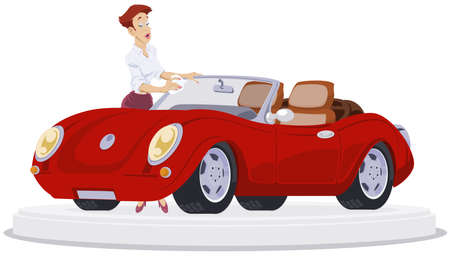1. Introduction to Car Show Judging
Car shows are more than just gatherings of automobile enthusiasts; they are competitive events where vehicles are assessed based on various criteria. Judges play a crucial role in determining which cars stand out among the rest, making their evaluations a key aspect of any car show.
The Role of Judges
Judges at car shows are responsible for evaluating vehicles based on specific guidelines. Their job is to assess a car’s condition, originality, modifications, and overall presentation to determine which vehicles deserve recognition. They use a combination of technical knowledge and aesthetics to score each car fairly.
Why Judging Matters
The evaluations provided by judges impact not only the competition results but also the value and prestige of the vehicles. Winning an award at a respected car show can increase a car’s market value and reputation in the automotive community. This makes the judging process essential for competitors and car collectors alike.
Key Aspects of Vehicle Evaluation
Judges typically focus on several important factors when assessing vehicles. These factors ensure a fair and comprehensive evaluation process. Here are the primary aspects they consider:
| Category | Description |
|---|---|
| Exterior Condition | The quality of the paint, bodywork, and overall cleanliness. |
| Interior Condition | The state of the upholstery, dashboard, and other interior components. |
| Engine Bay | Cleanliness, organization, and mechanical quality of the engine. |
| Originality | How closely the car adheres to its original factory specifications. |
| Modifications | The quality and execution of any customizations or performance enhancements. |
Judging Standards and Fairness
To maintain fairness, car show judges follow a standardized set of criteria when scoring each vehicle. Some events have strict classifications, ensuring that vehicles are judged against others in similar categories. Transparency in judging helps build trust among participants and spectators.
2. Key Criteria for Judging
In car shows, judges evaluate vehicles based on various factors to determine which ones stand out. Understanding these key criteria can help participants prepare their cars for competition. Here are some of the most important aspects judges consider:
Originality
One of the major aspects judges look at is originality. This means how closely the vehicle retains its factory specifications. Collectors and enthusiasts often place a high value on cars that have been preserved or restored with authentic parts and designs. Judges typically check:
- Whether the car’s interior and exterior match original specifications
- If original factory parts are used instead of aftermarket replacements
- Correct paint colors and finishes based on manufacturer records
Craftsmanship
Craftsmanship refers to the quality of restoration, custom work, and overall attention to detail. Even a car with a great design wont score well if the workmanship is poor. Judges assess:
- Precision of bodywork and paint application
- Fit and finish of panels, doors, and trim
- The cleanliness and organization of the engine bay
Presentation
First impressions matter, and presentation plays a huge role in judging. A well-maintained and properly displayed car stands out. Judges take into account:
- Cleanliness of the car inside and out
- Overall visual appeal and how well the car is staged
- Attention to detail, such as polished chrome and spotless glass
Historical Accuracy
For classic and antique car shows, historical accuracy is crucial. Judges compare a vehicle to its original factory specifications and historical context. They look for:
- Correct badges, emblems, and stitching patterns
- Authentic wheels, tires, and accessories
- Proper documentation proving authenticity
Key Judging Criteria at a Glance
| Criteria | What Judges Look For |
|---|---|
| Originality | Factory specs, original parts, color accuracy |
| Craftsmanship | Fit and finish, precision of restoration |
| Presentation | Cleanliness, visual appeal, staging |
| Historical Accuracy | Correct components, documentation |
Understanding these judging criteria can make a big difference in preparing a vehicle for competition. Whether restoring a classic car or showcasing a custom build, attention to detail in these areas can help improve a car’s chances of winning at a show.
![]()
3. Three, The Importance of Attention to Detail
When it comes to car shows, the smallest details can make a significant difference between a good vehicle and an award-winning one. Judges carefully inspect every aspect of a car, from its exterior paint finish to the cleanliness of the engine bay and the condition of the interior. These minor details collectively showcase the owner’s dedication, craftsmanship, and overall presentation.
Perfect Paint Finish
The quality of the paint job is one of the first things judges notice. A winning vehicle should have a flawless finish—no swirl marks, scratches, or uneven coatings. Professional detailing, regular maintenance, and proper buffing techniques are essential to maintaining a high-quality shine. Even a small imperfection can stand out under direct lighting.
Engine Bay Cleanliness
An engine bay should be spotless, free from dirt, grease, or leaks. Judges appreciate a well-organized and properly detailed engine compartment, as it reflects the owner’s commitment to the car. Components should be polished or painted, wiring should be neatly arranged, and all hoses and belts should be in excellent condition.
| Detail | What Judges Look For |
|---|---|
| Paint Finish | No scratches, swirl marks, or uneven application |
| Engine Bay | Clean, organized, and free of dirt or oil leaks |
| Interior Condition | Upholstery, dashboard, and carpets in like-new shape |
Pristine Interior Condition
The inside of the vehicle is just as important as the outside. Judges pay close attention to seats, carpets, dashboard, and trim. Faded upholstery, cracked leather, or worn-out buttons can subtract points. A winning interior should be in pristine condition, with every material clean and well-maintained.
Final Touches Matter
What separates a great car from a show winner often comes down to the little things. Polished chrome trim, properly aligned body panels, and factory-correct parts help create a flawless presentation. Owners who take the time to go over these details increase their chances of impressing the judges and taking home a trophy.
4. Subjectivity vs. Objectivity in Judging
One of the biggest challenges for judges at car shows is finding the right balance between personal preferences and standardized guidelines. While judging criteria help maintain fairness, every judge brings their own taste and experiences to the competition. Striking the right balance is crucial to ensuring that every vehicle is evaluated fairly.
The Role of Personal Preference
Even with strict guidelines, judges naturally have personal tastes when it comes to cars. They may prefer classic muscle cars, modern supercars, or custom builds with unique designs. This subjective preference can sometimes influence their scoring, even if unintentionally.
Examples of Subjective Preferences
| Judge’s Background | Possible Preference |
|---|---|
| Classic Car Enthusiast | Prefers original restorations over modern modifications |
| Performance-Oriented Judge | Prioritizes engine upgrades and speed potential |
| Customization Fan | Enjoys bold paint jobs and unique bodywork |
The Importance of Objective Criteria
To maintain fairness, car shows implement standardized judging criteria that help reduce bias. These guidelines focus on measurable aspects such as craftsmanship, cleanliness, presentation, and adherence to competition rules.
Standardized Judging Categories
- Exterior Condition – Paintwork quality, body panel alignment, and overall cleanliness
- Interior Condition – Upholstery, dashboard, and detailing
- Engine Bay – Cleanliness, modifications, and functionality
- Overall Presentation – How well the car represents its category
Finding the Perfect Balance
A great judge understands the importance of balancing personal opinions with objective standards. They must recognize their own biases and focus on the established scoring system. Car shows often use multiple judges to ensure a well-rounded evaluation, reducing the impact of any single persons preference.
Best Practices for Judges
- Follow the scoring system closely
- Avoid personal biases when evaluating a vehicle
- Discuss with other judges to maintain consistency
- Keep in mind the competition’s official rules and goals
By maintaining this balance between subjectivity and objectivity, judges help ensure that car shows remain fair and rewarding for all participants.
5. What Makes a Winning Vehicle?
When it comes to car shows, not all vehicles are created equal. Judges look for specific qualities that set a car apart from the competition. Whether youre entering a classic, muscle, or custom car, understanding these key factors can give you an edge. Below, we’ll break down what makes a winning vehicle and share some tips to help you impress the judges.
Key Factors That Distinguish a Champion Car
Judges evaluate vehicles based on a variety of criteria. While different car shows may have their own specific rules, the following are common aspects that contribute to a winning vehicle:
| Factor | Description |
|---|---|
| Overall Condition | Cars should be spotless, well-maintained, and in top condition, with attention to every detail. |
| Originality | For classic car categories, originality plays a major role. Authentic restoration work and period-correct parts are highly valued. |
| Customization | In modified divisions, uniqueness and creativity can make a car stand out. High-quality custom modifications should enhance the vehicle’s appearance and performance. |
| Paint and Finish | A flawless, high-quality paint job is essential. The finish should be smooth, consistent, and free of imperfections. |
| Interior Quality | Seats, carpeting, dashboard, and other interior elements should be in pristine condition and complement the car’s overall theme. |
| Engine Bay Cleanliness | A well-detailed engine bay shows dedication and hard work. No grease, dirt, or excessive wiring should be visible. |
| Presentation | How you display your car matters. Proper lighting, signage, and a well-thought-out setup can enhance your vehicle’s appeal. |
Tips for Impressing the Judges
To maximize your chances of winning, consider these helpful tips:
Pay Attention to the Smallest Details
Judges notice everything, from polished chrome to spotless windows. Make sure every inch of your car is meticulously cleaned and maintained.
Know Your Vehicle’s Story
Being able to share the history, restoration process, and unique aspects of your car can make a strong impression on judges.
Use High-Quality Parts and Materials
Whether restoring or modifying, using premium parts and materials will enhance the overall quality of your car.
Practice Proper Car Show Etiquette
Always be respectful to judges and fellow competitors. A positive attitude and enthusiasm for your vehicle can go a long way.
Display Your Vehicle Thoughtfully
Set up your car in a way that highlights its best features. Use signs, mirrors, and quality lighting to make it stand out.
By focusing on these factors and following essential tips, you can give yourself a competitive advantage in your next car show. Impressing the judges isn’t just about having a great car—it’s about perfecting every detail to ensure your vehicle truly shines.


